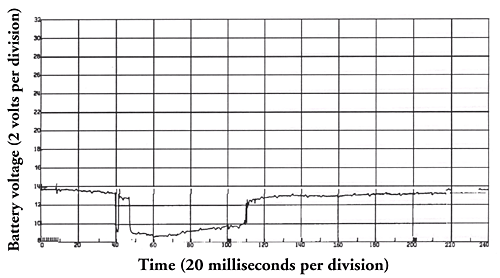Process: Complex Electrical Activity in Collisions
Process: Complex Electrical Activity in Collisions
The response of an automotive electrical system following a collision and during a fire can be very complex. Intermittent shorts have been identified in crash tests. In this example (below), involving a crash test on a 1997 Ford Explorer, internal alternator shorting was identified, which may have been the cause of the system voltage dropping between 40 and 110 milliseconds. There was no evidence of burning and charring in or around the alternator [1]. In this case, evidence of a short was found after a crash, but it did not result in fire. This underscores the complexity of electrical activity in crash and fire events, and the difficulty in assigning causality even to the evidence found.

In general, after a fire has started and regardless of its ignition source, the compromise of wiring and other electrical components during the fire can cause errant operation of any of the electrical systems on the car. It is not unusual for the starter motor to operate, the headlights to turn on or off, the wipers to actuate and the horn to honk. When such systems are energized due to fire-compromised insulation, evidence of short circuits unrelated to fire causation is expected. This should be kept in mind during the investigation phase when speaking with witnesses about their observations of the fire.
References